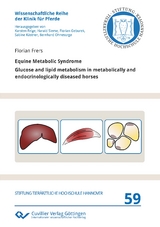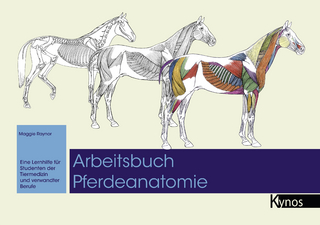Equine Metabolic Syndrome
Glucose and lipid metabolism in metabolically and endocrinologically diseased horses
Seiten
2023
Cuvillier Verlag
978-3-7369-7805-8 (ISBN)
Cuvillier Verlag
978-3-7369-7805-8 (ISBN)
https://cuvillier.de/de/shop/publications/8831-equine-metabolic-syndrome
The term insulin dysregulation encompasses different disturbances of insulin regulation in equids, including basal or a pathological high postprandial hyperinsulinemia and/or peripheral insulin resistance. Alterations of insulin signaling, as seen in human type II diabetes mellitus, might be associated with the development of insulin dysregulation, but the underlying pathomechanisms have not been elucidated yet. Therefore, the objective of this study was to determine key proteins of the insulin signaling cascade in insulin dysregulated and healthy horses under basal conditions and after an oral glucose and intravenous insulin challenge. Secondly, the insulin and glucose response to an IV insulin and oral glucose challenge was described to assess glucose and insulin dynamics following different challenges. In principle, insulin signaling was maintained, but the signaling cascade was modified, especially at post-receptor events, in relation to the source of insulin. Thus, ID seems to be an equine-specific metabolic condition, in which alterations of the mTOR signaling pathway may play a crucial role, emphasized by higher mTOR phosphorylation in ID horses. Furthermore, the results of the study support that both terms, hyperinsulinemia and insulin resistance, have to be clearly distinguished in the context of insulin dysregulation.
The term insulin dysregulation encompasses different disturbances of insulin regulation in equids, including basal or a pathological high postprandial hyperinsulinemia and/or peripheral insulin resistance. Alterations of insulin signaling, as seen in human type II diabetes mellitus, might be associated with the development of insulin dysregulation, but the underlying pathomechanisms have not been elucidated yet. Therefore, the objective of this study was to determine key proteins of the insulin signaling cascade in insulin dysregulated and healthy horses under basal conditions and after an oral glucose and intravenous insulin challenge. Secondly, the insulin and glucose response to an IV insulin and oral glucose challenge was described to assess glucose and insulin dynamics following different challenges. In principle, insulin signaling was maintained, but the signaling cascade was modified, especially at post-receptor events, in relation to the source of insulin. Thus, ID seems to be an equine-specific metabolic condition, in which alterations of the mTOR signaling pathway may play a crucial role, emphasized by higher mTOR phosphorylation in ID horses. Furthermore, the results of the study support that both terms, hyperinsulinemia and insulin resistance, have to be clearly distinguished in the context of insulin dysregulation.
| Erscheinungsdatum | 13.06.2023 |
|---|---|
| Reihe/Serie | Wissenschaftliche Reihe der Klinik für Pferde ; 59 |
| Verlagsort | Göttingen |
| Sprache | englisch |
| Maße | 148 x 210 mm |
| Themenwelt | Veterinärmedizin ► Pferd |
| Schlagworte | 2-step insulin response test, 2-step IRT • 2-Stufen Insulin-Stimulationstest, 2-Stufen IST • Adiposity, Regional fat accumulation • Ems • Endokrinopathisch, Hyperinsulinämie • Equines Metabolisches Syndrom • Glucose • Glucose homeostasis, Laminitis, Endocrinopathic • Glukosehomöostase, Hufrehe • Hyperinsulinemia, Equine, Icelandic horse • InsR, Proteinkinase B • Insulin • Insulin receptor, Protein kinase B, Protein metabolism • Insulin signaling cascade, Key protein • Insulinsignalkaskade • Insulin-Stimulationstest • Mechanistic target of rapamycin • Mechanistic target of rapamycin, mTOR, Insulin Rezeptor • Oral glucose test, Insulin response test • Pferd, Islandpferd, Adipositas • Pituitary pars intermedia dysfunction • PKB/Akt • ppid • Protein, Diagnostik, Phosphorylierung • Proteinstoffwechsel, Equine metabolic syndrome • Regionale Fettdepots, Western Blot • Schlüsselprotein, Oraler Glukose Test • Western Blot, Diagnostics, Phosphorylation |
| ISBN-10 | 3-7369-7805-7 / 3736978057 |
| ISBN-13 | 978-3-7369-7805-8 / 9783736978058 |
| Zustand | Neuware |
| Informationen gemäß Produktsicherheitsverordnung (GPSR) | |
| Haben Sie eine Frage zum Produkt? |
Mehr entdecken
aus dem Bereich
aus dem Bereich
Eine Lernhilfe für Studenten der Tiermedizin und verwandter Berufe
Buch | Hardcover (2017)
Kynos (Verlag)
36,00 €




